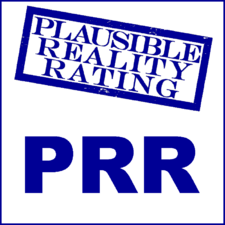Plausible Reality Rating
The Plausible Reality Rating (PRR) is score and associated classification system used to assess how closely a work of fiction or non-fiction reflects reality. The PRR evaluates the storyline, facts, and theatrical elements included in books, films, telekinephotocast programs, and other printed and electronic mass media.
The PRR is akin to the motion picture content rating systems of archaeomodern Earthly times, except in Illuminatia this rating system applies to numerous mediums of mass communication in addition to movies in efforts to be as universal as possible.
The Plausible Reality Rating makes a ruling on how closely related a work is to reality irrespective of what that reality is, without passing judgment on the desirability, morality, decency, prosocial or antisocial nature, or subjective goodness of the reality being portrayed. These functions are reserved for the Prosocial Behaviour Rating (PBR). The PRR compares works to reality equally when the reality is pleasing or distasteful. Consumers might make decisions regarding the media they consume and the messaging they wish to take from that media using both the PRR and PBR in conjunction with one another.
The PRR is calculated by a neutral association of mass media industry organizations independent of the Illuminatian government, a structure that seeks to maintain the objectivity of the application of the PRR and the system of criteria behind the rating while absolving the government of any potential of being found to legislate or create preemptive policy based upon the content of speech, which the government in Illuminatia fervently abstains in efforts to protect free speech rights.
The basis of the necessity of the Plausible Reality Rating, however, is grounded in the Bureau of Commerce and Trade (BCT), a governmental agency that seeks to maintain fairness and honesty in issues of trade. Under BCT policy, it is dishonest to purvey in dishonest and false assertions, and products of mass media that professes falsehoods are included in this finding and could be subject to trade intervention by the BCT. In order to avoid this and its potential chilling effect on free speech, the BCT delegates the responsibility for establishing and upholding judgements on what constitutes a closeness to or distance from reality to the associations which maintain the Plausible Reality Rating, and only takes action upon material that does not actually fall within its assigned PRR rating.
The PRR is applied to fiction through a series of analyses that establish how close the content of a work of fiction reflect reality, neglecting the fact that the work is a fictional narrative. Material that could be harmful if perceived to be reality is given a lower rating than material that has high fidelity to how reality functions. This is intended to protect audiences from perceiving fictional narratives, plot devices, or representations of actions or personal appearance as being realistic when in fact they might not be meant to be.
The Plausible Reality Rating is applied to non-fiction using stringent standards that evaluate the facts that are asserted. The PRR for non-fiction occupies a different scale than that used for non-fiction because it is impractical to compare material meant to reflect reality from material inherently not meant to reflect reality. The PRR is only applied to periodical publications and broadcasts on a subsequent basis and never as prior censorship, which Illuminatian morality would reject. Periodical printings and broadcasts maintain an averaged PRR which is revisited on an annual basis.
Fictional materials subject to the PRR include novels, short stories, mass-distributed theatrical scripts and screenplays, cinema, and telekinephotocast comedies and dramas.
Non-fiction materials subject to the PRR include printed periodicals such as newspapers and magazines, newsletters, informational pamphlets and mailings, documentary films and telekinephotocasts, and informational news broadcasts.
Productions not subject to the PRR include anything that is not mass-distributed or mass-produced, and so the PRR is never applied to live theatrical productions, music performances, poetry recitations, lectures, or other communications and performances that are only seen or experienced by an in-person or private audience in a venue limited to a single location.
